Time to explore the known history of another of my ancestors, this time great-grandfather Jack (christened John) Harrison. A fitting choice for a Remembrance Sunday weekend, being the only one of my direct ancestors that I know served in a World War.
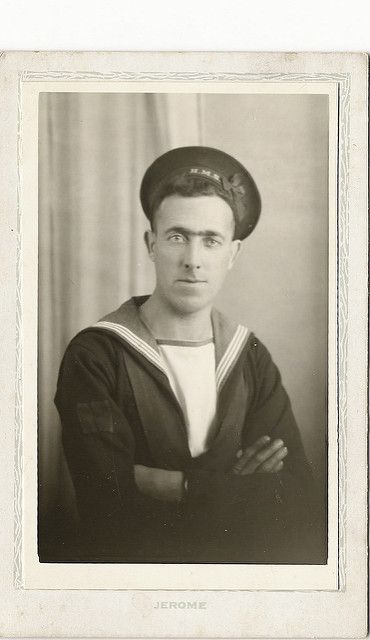
Jack was born 29 April 1899, at 33 Crosby Street. His father was John Harrison, a Journeyman Hatter at the time; his mother was Hannah Harwood. I’ve previously explored the life of his father John, in another post.
John, known for most of his life as Jack, was the 3rd surviving child out of 9; he was also the 3rd son. At the time of his birth, the family were living at 33 Crosby St, Stockport, a typical 2 up 2 down of the time.
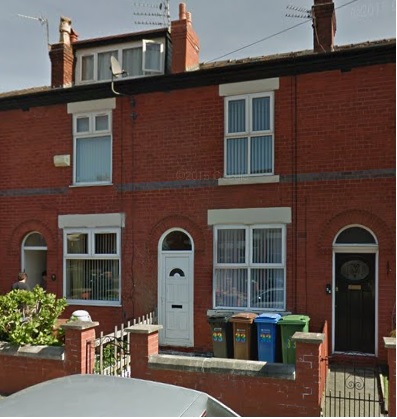
They were still there for the 1901 census but 10 years later, they’d moved to 97 London Rd, which looks to be very similar. There were 8 children living with the family at that point, which must have been cramped. The 2 oldest sons were out earning; Leonard, at 17, was a hairdresser and Sydney, 14, was a Grocer’s Errand Boy. Jack and 2 sisters, (Lizzie and Lily) were at school and 3 children were at home – Fred (4), William (3) and Norah (1). This house was to remain the family home for years – it was the recorded death place of John’s parents 40 years later. Today, it’s a bridal shop.
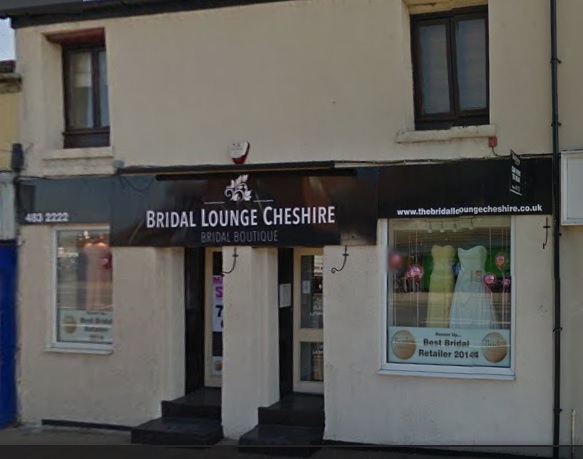
Three years after this census, World War one broke out. Jack was 14. The school leaving age was 12, so we can assume he’d been working for a few years. But if he was eager to follow the patriotic call, he was too young to sign up for the Army, with the official age set at 18 and soldiers not supposed to serve abroad until they were 19. But many underage boys did manage to serve; analysis of records show that nearly a third of the Navy recruits were underage. In 1916, the UK government started subscription – but he would have still been too young for this. But the Navy were slightly different; you could join them young as a ‘Boy‘, with parents’ permission. Many of those boys, nominally at ‘school’ were sent to sea.
If we look at his older brothers, both did sign up, with the Army, but potentially Jack was the first to join.
- Leonard Harrison. Enlisting in Dec 1915, aged 22, he served in France. On 26 April 1919, there’s a record of his transfer to the Reserve; he’d been serving in the Royal Horse & Field Artillery, 58th Divisional Ammunition Column. These papers list job as a Driver and his address as 97 London Rd. There’s also a Medal card listed at the National Archives – I’ll have to go and find this at some point.
- Sydney Harrison. We know Sydney joined the Army – he sent this photo to his Aunt Alice, but not yet identified which record was his.

So what about Jack? Here’s his service record:
- Volunteered 4/5/1915, started service 29/4/1917. Served until 23/10/1919
- HMS Powerful 5/5/1915-22/11/1915 Training in Devonport, Boy 2nd Class
- HMS Victory 23/11/15-27/1/16 Still on shore, promoted to Boy 1st Class
- HMS Malaya 28/1/16 – 27/4/18
- HMS Sable 28/4/18-7/3/19 An R Class Destroyer
- HMS Royalist 14/3/19-12/7/19 A Light cruiser
- HMS Victory 13/7/19-23/10/19 Back on shore
So 5 days after his 16th birthday, Jack signed up for the Navy. His brothers did not appear to be in the forces yet so it did not appear to be family expectations. Was it friends? Did they join up together? Whatever it was, at 16 Jack was heading down to the South Coast for training. How did that feel, to someone who was unlikely to have travelled before. Six months of training followed before he was posted to HMS Victory, usually used to refer to holding barracks in Portsmouth, when sailors were waiting for posting. He’d graduated to being a Boy 1st Class and spent 2 months waiting for the next step.

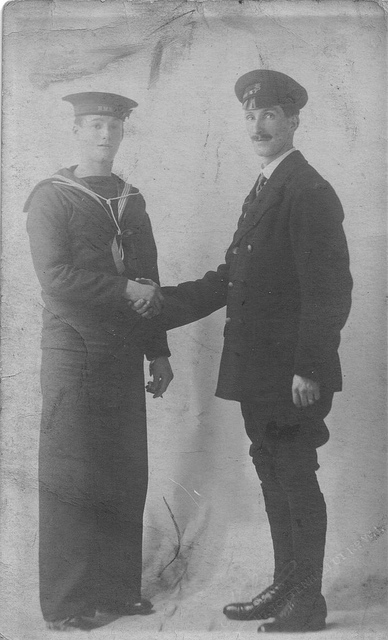
That next step was the HMS Malaya, a brand new ship. Jack joined the crew 3 days before its official commissioning, one of most junior members of the 1200+ crew. The ship joined the 5th Battle Squadron ; what it did for the next 4 months I don’t know but on 31 May 1916, they played a part in the Battle of Jutland. At the end of the engagement, the ship had lost 65 crew, with 68 injured. Despite the damage, it got back to port for repairs before sailing again in July.
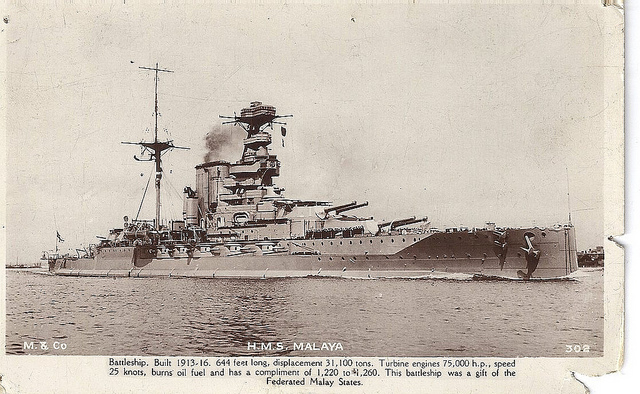
They appear to have a quiet summer, according to this postcard to his 7 year old sister Norah implies.
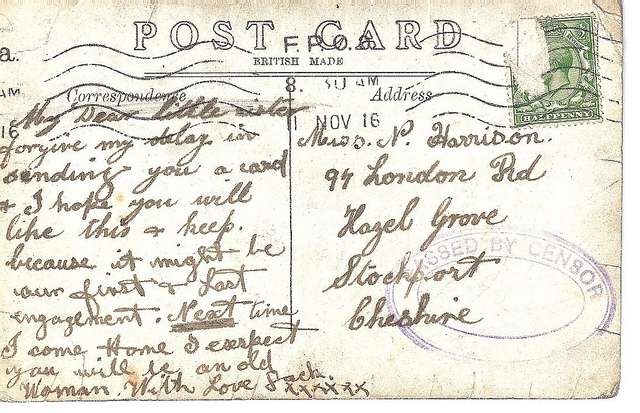
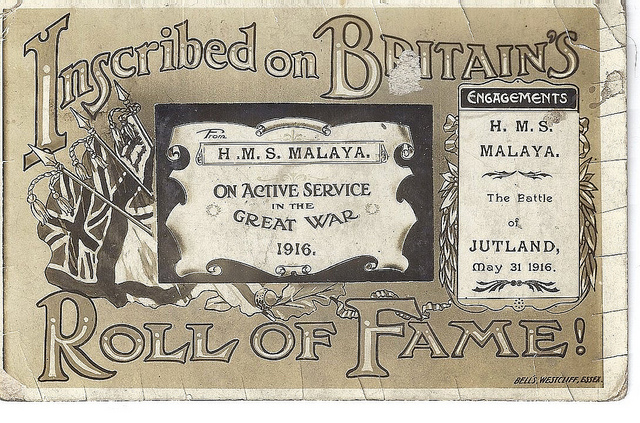
Jack carried on with the ship, being promoted to Ordinary Seaman on 29 Apr 1917 and Able Seaman 5 months later on 1 Sep 1917. In April 1918 he was moved to HMS Sable, a destroyer ship with a much smaller crew of only 82. He was with this ship until March 1919. We can assume that during this time he managed to get home a few times, because he was obviously courting. On 11 Feb 1919, Jack married Lillian Robinson.
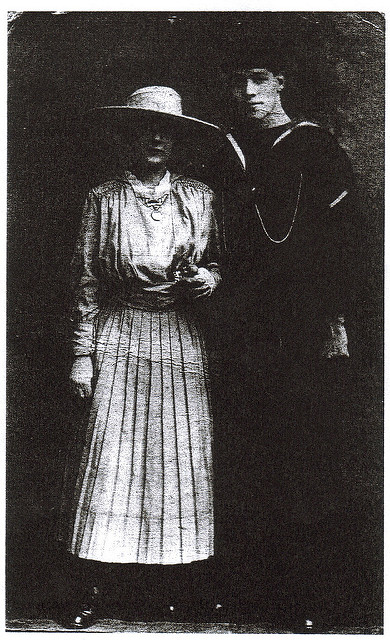
Lillian was the daughter of a local tobacconist and building merchant William Robinson, a Yorkshireman who’d moved across the Pennines and one of the founding members and first team captain of Stockport Rugby Club. He was good enough to play for Cheshire country team. Stockport was one of the founder members of the new Rugby League and we can assume that William played a major part in this, given his prominence in the club.

There was one more stint at sea, before Jack finally left the Navy in October 1919. Time to settle down, stat the family and get on with life. His first daughter, Mabel was born in 1920; Lillian, my Grandmother, was born in 1922. It was 15 years before another child was born – John Leslie, in 1937. There are no other records of any other children apart from these 3.
There’s no records over the next 20 years, until the 1939 Register when we find them in Roscoe St, still in Stockport. Another typical terraced house.
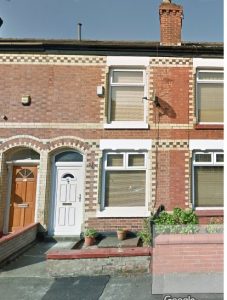
At this point we have Jack and Lillian, living with John Leslie and their daughter Lillian, along with a lodger Arthur. Their other daughter can be found back in the family home in Castle St, with her grand-parents. Jack was now a Locomotive Fireman – looking after the boilers on trains.
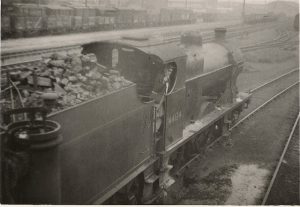
He was also breeding dogs at the address; we have an old business card “J Harrison, Breeder of Classical Pedigree Wirehaired Fox Terriers; Malayan Kennels, 26 Roscoe St, Edgeley, Stockport Owner of Fyldelands Starlight”. Naming the star dog implies it was a good dog from a famous breedline. The only other mention i can find to Fyldelands is to a best in show dog from St Louis in 1931, so definitely from an international breeder. And the name of the kennels was a callback to his WW1 Navy Career.
None of the family appeared to have served in WW2, too old or too young. In 1943, Jack’s daughter Lillian moved out, marrying another Jack, my grandfather. Mabel never married.
Jack’s wife Lillian died in 1956 and was buried in Cheadle Cemetery. Just over a year later, tragedy struck again, with John Leslie, at only just 20, also dying. Jack stayed in the same house for the next 20 years, before dying in the local hospital in 1977, at the age of 77. He was buried in the same grave as his wife. I may have met him, but I don’t remember. As the family was living 100miles further south, I do know we did not make that many visits.
As with his father, a man that lived through many changes. Born in the last years of Victoria he served in WW1 and lived through WW2. He was born before planes and died when package holidays were starting to become available to the wider populace – did he ever get on a plane? Did he ever travel far after his journey’s in the war? so many questions, no-one to ask any more.